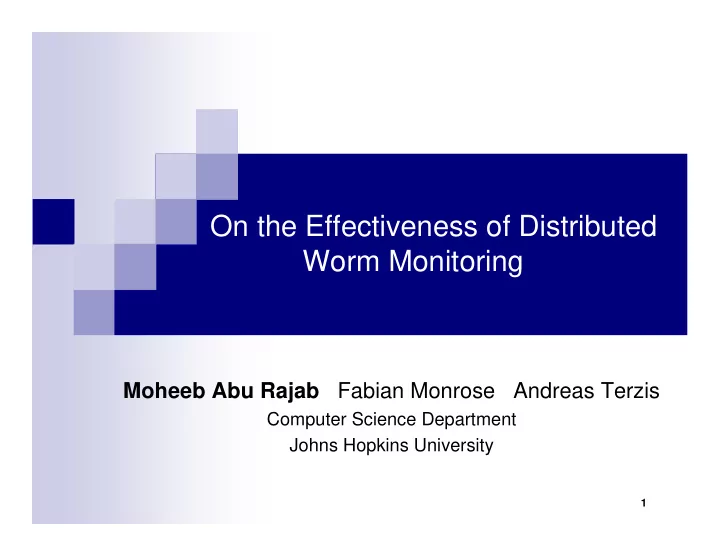

On the Effectiveness of Distributed Worm Monitoring Moheeb Abu Rajab Fabian Monrose Andreas Terzis Computer Science Department Johns Hopkins University 1
Monitoring Internet Threats � Threat monitoring techniques: � Intrusion detection systems monitoring active networks � Monitoring routable unused IP space [ Moore et al, 2002 ] � Monitoring unused address space is attractive � No legitimate traffic � Forensic analysis and early warning � CAIDA deployed the first /8 telescope 2
3 Worm Scans DoS Attack DoS Backscatter /8 Worm Scans Single Monitor Case DoS Attack
Size Matters! � Size of the monitor is an important factor in providing an accurate view of a worm breakout [Moore et al, 2002] � But there are several other factors yet to be explored 4
5 Single monitor view is too limited Non-uniform scanner /8 Worm Scans DoS Attack
Goals � Provide a model to evaluate the performance of distributed monitoring systems in terms of: � Number of monitors? � Sizes of monitors and the overall IP space requirements? � Provide guidelines for better design and monitor deployment practices. 6
Outline � Problem and Motivation � A Worm Propagation Model � Population Distribution � Extended worm model � Distributed Worm Monitoring � Distributed Telescope Model � Design parameters � Summary 7
Why another worm model? � Previous worm models assumed that the vulnerable population is uniformly distributed over the whole IP space. � Sources of non-uniformity in population distribution � Un-allocated address space � Highly-clustered allocated space � Usage of the allocated space 8
Population distribution DShield dataset CAIDA’s dataset (Witty Worm) The distribution of Vulnerable population over the IP space is far from uniform Best fits a Log-normal distribution 9
Extended Worm Propagation Model � Worm propagation models must incorporate population density distribution. � Especially Non-uniform scanning worms: � Probability of scanning a host depends on its location relative to the infected scanner 10
Non-uniform worm propagation model � Expected number of scans per /16 subnet 16 16 2 2 = + + j j (/ 8 ) k p s b p s b p s n i 16 i 8 i 0 i 24 32 2 2 2 32 - 2 8 2 8 - 2 16 2 16 v i b i n i (/8) b i P 16 P 8 P 0 11
Non-uniform worm propagation model � The expected number of infected hosts per /16 subnet (AAWP Model [ Chen et al,2003 ]) ⎡ ⎤ j k ⎛ − ⎞ i 1 ⎢ ⎥ = + − − ⎜ ⎟ j j j b b ( v b ) 1 1 + i 1 i i i ⎝ ⎠ ⎢ 16 ⎥ 2 ⎣ ⎦ Vulnerable non- infected hosts � The expected total infection 16 2 ∑ + = j n b i 1 i = j 1 12
Impact of population distribution Number of Infected hosts vs time, for a Nimda-like worm s= 100 scans/time tick , P 16 = 0.5, P 8 =0.25, P 0 = 0.25 N= 10 6 hosts uniformly distributed N= 620,000 hosts extracted from Over the IP space DShield data set 13
Outline � Problem and Motivation � Better Worm Model � Population Distribution � Extended worm model � Distributed Worm Monitoring � Distributed monitoring system model � Design parameters � Summary 14
Using the Model--- Distributed Monitoring: � What do we want to evaluate? � System detection time: the time it takes the monitoring system to detect (with particular confidence) a new scanner. 15
Assumptions � Single scan detection � Information sharing and aggregation infrastructure among all monitors. 16
S (/0) = M + M A + M B + M C S (/16) = M C 17 S (/8) = M B + M C M C M C Monitors Logical Hierarchy M B P 8 M B P 0 M A M P 16 /8 M A /16 /0 /8
Evaluation � Nimda-like scanner � Three Monitor deployment scenarios: � Random monitor deployment � Full knowledge of population distribution � Partial population knowledge 18
Evaluation (Random monitor placement) /8 � 940 time ticks with only 40 hosts per /16, 512 /17 � 230 time ticks 7100 more scans will cause infecting 2 victims Random Monitor placement before being detected P r = 0.999, s= 10 scans/time tick 19 Nimda-like scanning
Evaluation ( Full vulnerable distribution knowledge) /8 � 940 time ticks 512 /17 � 9 time ticks Monitors deployed in top populated prefixes 20
Evaluation (Partial Knowledge ) /8 � 940 time ticks 512 /17 � 33 time ticks Example: 512 monitors with Monitors deployed randomly over the 2048 IP addresses/monitor 5000 most populated /16 prefixes � 160 time ticks (contain 90% of the vulnerable 21 population)
Practical Considerations � Monitors will be deployed at different administrative domains. � How many domains are needed to deploy these 512 monitors? � Mapping the monitors to AS space, only 130 AS’s among the top address space owners are required to achieve detection time of 160 time ticks 22
Summary � Population distribution has a profound impact on worm propagation speed. � Distributed Monitoring provides an improved detection time (three times faster than a single monitor of equivalent size). � Even partial knowledge of the population distribution can improve detection time by roughly 30 times. � Effective distributed monitoring is possible with cooperation among top address space owners. 23
24 Questions?
Recommend
More recommend